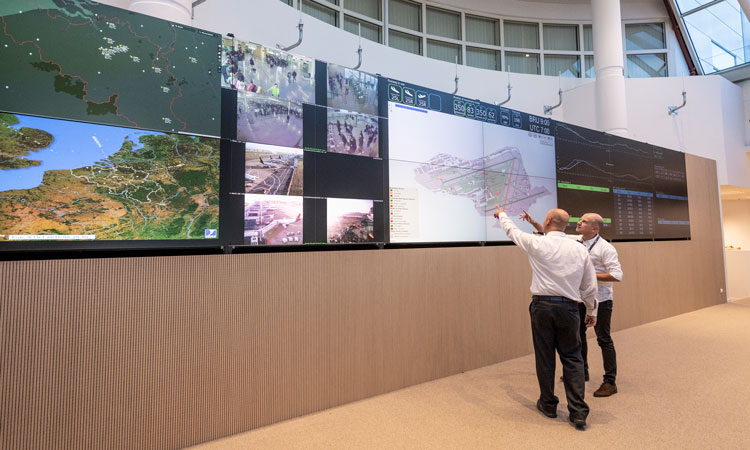The secret weapon helping airports weather the crisis: Predicting the future
- Like
- Digg
- Del
- Tumblr
- VKontakte
- Buffer
- Love This
- Odnoklassniki
- Meneame
- Blogger
- Amazon
- Yahoo Mail
- Gmail
- AOL
- Newsvine
- HackerNews
- Evernote
- MySpace
- Mail.ru
- Viadeo
- Line
- Comments
- Yummly
- SMS
- Viber
- Telegram
- Subscribe
- Skype
- Facebook Messenger
- Kakao
- LiveJournal
- Yammer
- Edgar
- Fintel
- Mix
- Instapaper
- Copy Link
Posted: 4 August 2021 | Fran Kauzlaric | No comments yet
Fran Kauzlaric, Innovation Lead at Brussels Airport Company, shares how the airport’s use of innovative technologies to ‘predict the future’ has brought some much needed certainty to the uncertain times of the pandemic.


It’s in human nature to adapt, evolve and innovate in a crisis – and we’ve seen an incredible amount of innovation across our industry throughout the COVID-19 pandemic. From autonomous robots disinfecting entire terminals, to touchless ways of doing just about anything as you speed through the airport. A lot can be said about the last year and a half – but, we can’t say there has been a lack of high-profile gadgets and technologies entering airports. Some of these will have a significant impact on the way we travel, now and in the future; while others might stick around less than perhaps was anticipated.
At Brussels Airport, we’ve had our share of technology innovation as well, but if someone asked me to highlight the one thing that I would have wanted to work perfectly throughout the crisis – the magic bullet, the holy grail that can help an airport weather a crisis like no other – it would be a really simple answer: the ability to predict the future.
If you can tell us how many passengers we will have tomorrow, next Friday, during our August peak or at Christmas time – we, as the airport operator, can optimise our costs, boost revenue per passenger, prepare the terminal in just the right way and ensure a smooth, cost-efficient operation for all our passengers, staff and concessionaires.
Pre-COVID, Brussels Airport had the ability to predict the future with a 98 per cent accuracy, and we were quite proud of that. Imagine that – knowing with 98 per cent certainty the number of passengers that will arrive to your check-in next weekend. Ninety-eight per cent confidence of the number of passengers to pass through your security checkpoints; buy a cup of coffee, or check out the latest selection of finest Belgian chocolates.
Queues result in revenues lost
This certainty helps us in ways we couldn’t have imagined 10 years ago. It helps us have the right number of security staff planned for each day of the week, ensuring we optimise passenger experience at the lowest operational cost possible. Queues are not only bad for passenger satisfaction, they are certifiably bad for business, and we’ve managed to quantify exactly how bad – by calculating how much less likely a passenger is to shop or enjoy some of our restaurants for every extra minute he spends in the security queue.
That certainty helps us predict the number of buses we will need at any point in time. It helps us plan our winter operations through detailed management of our de-icing machines. It helps us allocate gates in the most optimal way. It also helps in deciding which check-in counters to use, when to use them, and which baggage belts will ensure optimum distance between arriving passengers.
Airport Operations Plan
When we embarked on our Airport Operations Plan project in 2017, we knew the price tag upwards of €22 million would be worth it – we just had no clue it would help us to this extent – to weather the single greatest crisis our industry has ever seen. Connecting data between different airport processes (passenger, bag and aircraft) helps us through each of the phases of our decision making: forecasting (from one month to six), real-time monitoring, mitigating and post-ops continuous improvement. An essential part of this is use of machine learning models in our existing passenger forecasting. Models that used to take us weeks to re-run now take us minutes due to a high level of automation, allowing not only frequent re-runs, but also expansion of the scope of our forecasting team to several other processes, including bags, bussing, and passengers with reduced mobility (PRM).
Valuable insight during a pandemic
Although we could not achieve the near perfect 98 per cent accuracy during the crisis, we still managed a high 86 per cent, which was immensely helpful given there was no known precedent in history that we could rely on. Our models are able to understand years of historical data and capture trends at the highest level of detail. These models give more weight to more recent data, meaning they are tremendously adept at picking up new situations very quickly. As a result, the technology remained reliable during the pandemic and the outcomes of the models became even more critical in making decisions such as which infrastructure is needed and how many resources should be deployed in the most cost-efficient manner.
With COVID-19 shaking customer trust in air travel, passenger satisfaction became even more critical for us at Brussels Airport, and we now aim for waiting times to never exceed 10 minutes. This is only possible because passenger forecasts are regularly shared with our screening provider, from which we dynamically order different numbers of open lanes and staffing depending on traffic peaks. This overall approach on screening resulted in a cost reduction of 10 per cent per year and an increase in spend-per-passenger of one per cent, as passengers have more time to browse the terminal shops.
In conclusion, our ability at Brussels to tell the future has proven one of the most useful and important innovations of the recent crisis. However, our forecasting models, driven by artificial intelligence (AI), do not do the trick on their own. They are merely part of a system and a way of working across our airport. At the heart of it is a data- and performance-driven culture, where our colleagues understand the input and trust the output of data analytics. To get there, we went through years of changing ‘hearts and minds’, way back to 2015, when we founded our APOC. That was the point which got us moving towards a proactive and data-driven decision making long before AI came in and enhanced it.
So back to the little robot running around disinfecting things from the beginning of this story – in the midst of the storm, of course having gadgets can be useful. Comforting even! But, if I had to pick and choose and spend money on one thing – it wouldn’t be the disinfecting robot. It would be a different kind of robot – an invisible one, with power to tell me what tomorrow brings.
Numbers are a wonderful thing. Invest in them, and they will bring a solid return.
Biography


Previously at Market Gravity (a Deloitte business), Barclays and PwC, his experience includes proposition design, corporate strategy, M&A as well as partnerships negotiation and assessment. In his free time, he enjoys skiing, mountaineering and diving.
Related topics
Air freight and cargo, Airport development, COVID-19, New technologies, Passenger experience and seamless travel, Passenger volumes


















